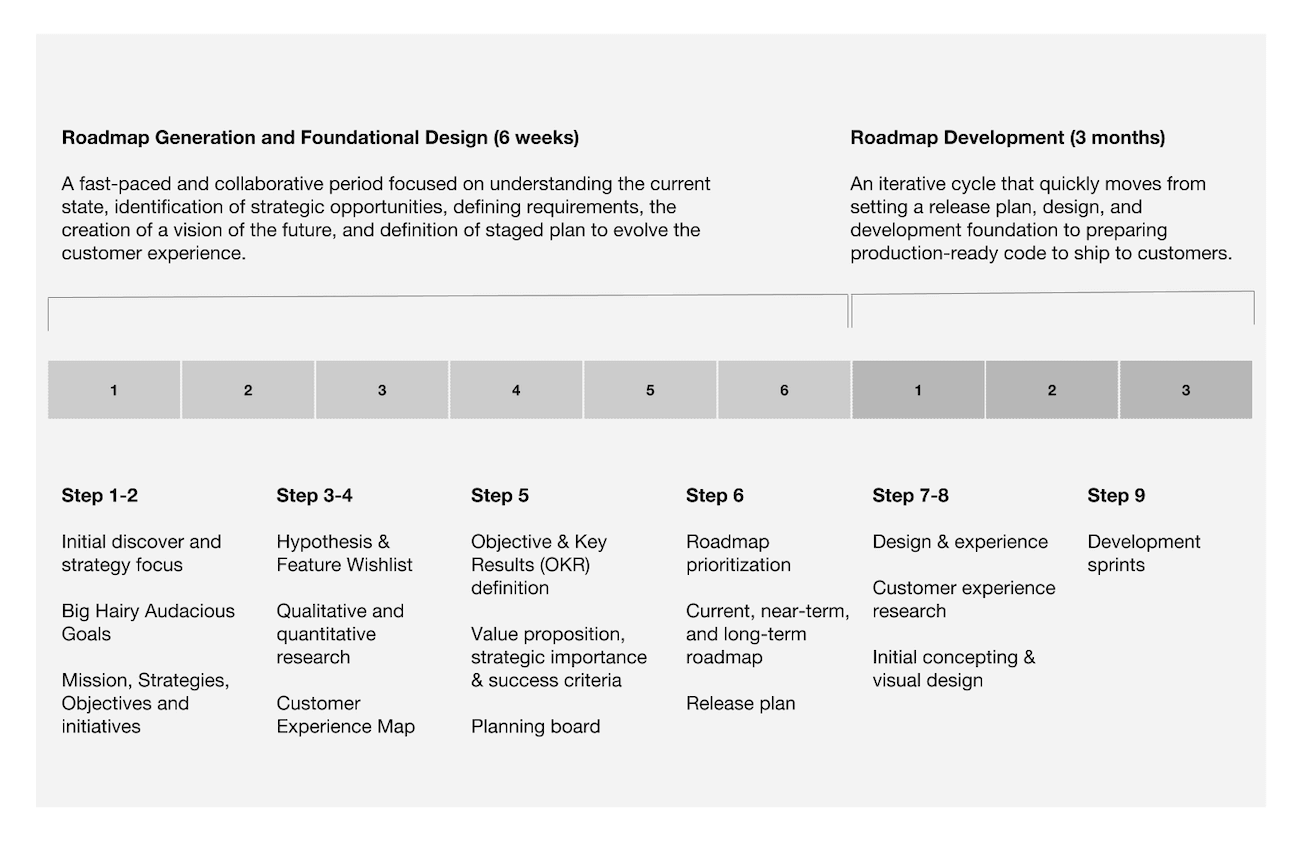Can’t Prioritize? Use This Six-Week Process to Create Your Roadmap
Despite the proliferation of roadmapping tools, prioritization remains the most difficult part of the process. Without a way to reinforce the order of roadmap items, it just won’t stick.
Over my years as a PM, I’ve established an effective roadmapping process. With this, and backed by effective strategy and strong leadership, I’ve helped develop roadmaps that successfully align individuals and companies. Toward the end of any given quarter, I often rely on this fast-paced and collaborative six-week process to refine priorities. I focus it around understanding the product’s current state, identifying strategic opportunities, defining requirements, creating a vision of the future, and defining a staged plan to evolve the customer experience. Here’s a breakdown of my process.

Weeks 1 and 2: Initial discovery and focus on strategy
I spend the first weeks of the project developing a more detailed, shared understanding of the intent and objectives of the product’s current state. Without a sense of purpose or scope, anything we do is equally ok. But once we establish intent, I can start attacking the plan in a methodical way. I do that by setting objectives. For example, I’ll conduct an audit of the existing ecosystem to catalog the range of products, components, and features that we’ll need to shift to the new roadmap.
Also, I’ll interview key stakeholders to get their perspective on which objectives are most valuable. In these sessions, I identify key business strategies, customer motives, and technical constraints that could impact the product roadmap.
Weeks 3 and 4: Hypothesis and feature wishlist
After defining the product’s intent, strategies, and objectives, I dig deeper into the highest-priority needs. I conduct up to ten customer interviews to gain a better understanding of both known and latent customer pain points. Interview sessions may be conducted in-person, via phone, or via store intercept. Then, I propose an experience map to define the structure of the customer journey.
A defined experience map facilitates discussions and proposes initiatives for how key features and components deliver measurable value to the product. Finally, I document the outputs of these sessions in a feature wishlist parking lot.
Week 5: Definition of OKRs
I start this part of the process with a collaborative conception workshop, which acts as a deep dive into the diverse range of proposed wishlist features. Next, I’ll bring together key stakeholders, decision-makers, and subject matter experts to explore how these initiatives should align with strategic business objectives. I then refine and expand the best of these approaches. I’ll also identify high-priority OKRs (objectives and key results).
One main goal will be to take all that inspirational language and quantify it clearly by identifying and recording the value proposition, problems to be solved, and success criteria. These will be used to focus stakeholders around a bold goal.
Week 6: Roadmap prioritization
At this stage, I begin converging the OKRs into a unified roadmap to prepare for iterative development sprints. Roadmaps are essential to giving your organization direction, motivating teams, and ensuring we deliver the right thing in the right time frame.
An OKR sets a goal for a set period of time, usually the quarter. With key strategic and value propositions made, I meet with stakeholders to select and rank the top OKRs. Also, I ensure they commit not to changing the rankings for three months.
In parallel, I’ll work with engineering and a project manager on a release plan for the upcoming quarter. The release plan includes requirements, committed available resources, and planned release dates for chosen initiatives.
Bringing it all downstream
Over the following weeks, the UX/design team and I will build wireframes that represent the key functional areas of the core user experience. At the same time, we’ll work iteratively on the visual presentation direction and begin converging the conceptual, visual, and technical workstreams into a unified design approach. In addition, I’ll begin technical planning with the engineering team to explore different technologies and frameworks that will support our requirements. In parallel, I’ll work with data science metrics collaborators to envision key feature uses. We’ll identify measurable elements, making sure results are normalized and comparable so we can tell if an objective has been met.
Standards for your roadmap
Not all products are created equal. It comes down to gathering real-world feedback and making decisions on what features to build. Lay out very clearly what you learned about actual customers through qualitative and/or quantitative knowledge. State the additional problems you look forward to solving and propose solutions to increase customer value while tying them to business results. Product management often lacks standards — here’s one you can use to succeed with digital products.
Author’s note: Thanks to Judy Wong for reading drafts of this. Also, if you have any feedback or criticism about this article, shoot me an email.
Bain Public is a product consultancy that helps companies make smart decisions and ship top-notch products that captivate customers and achieve business objectives. We help ambitious organizations create new value by establishing company-wide, product-related processes. Our group of experienced product managers works closely with C-suite leadership teams to remove friction from all touchpoints of the digital consumer experience. We help teams deliver product-market fit, allowing companies to operate at scale. For more information, visit bainpublic.com.


